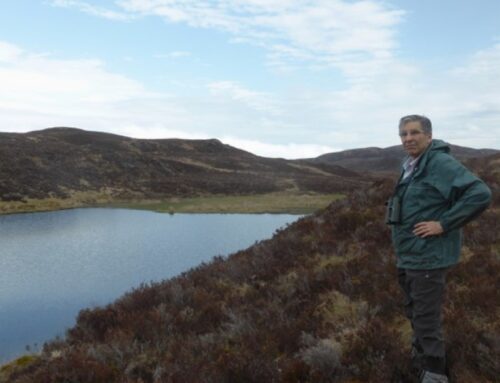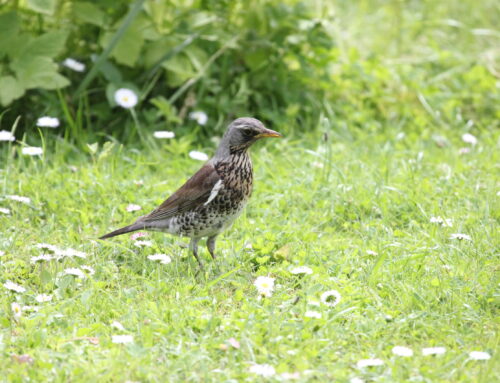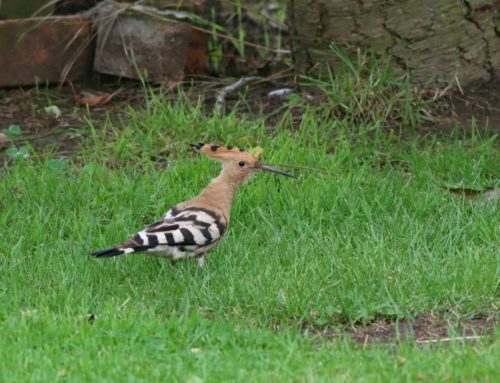Baillon’s Crakes in Yorkshire in 2022
Baillon’s Crakes were present at a site in East Yorkshire during the 2022 breeding season. The news of this occurrence was withheld at the time, for very valid reasons. One of the observers, who remains anonymous, has kindly provided an account of the finding of the birds, as well as the considerations faced over whether news could be shared with the birding community.

A distant shot of a Baillon’s Crake at the East Yorkshire site, just about visible in the centre of the photo
Baillon’s Crake is a very rare but increasing suspected breeding visitor to the UK, frequenting habitats that make detection and precise monitoring difficult. During June-July 2022 two singing males and one probable female were heard and observed in East Yorkshire, although ultimately breeding could not be confirmed.
On 21st June 2022 two Baillon’s Crakes were surprisingly discovered feeding together along the edge of a small area of open water within a larger area of marsh at an undisclosed and private location in East Yorkshire. Despite continued observer presence that day they weren’t seen again but remarkably in the evening a bird was heard singing. A bird was seen in the same area the following morning and occasionally thereafter but despite probably a hundred hours spent monitoring the site all sightings totalled only a couple of minutes of observation.
When initially seen no aggression was witnessed between the two birds this despite a bird being on territory that evening, subsequently probable female type calls were recorded from this area. This strongly suggested that at least one pair was present.
Singing was noted regularly thereafter in suitable weather conditions and on 25th June a second presumed male was heard singing with the two males being approximately 80-100 metres apart. Song continued sporadically from both competing males until the second bird was last heard on 17th July and the final sighting was of a bird in the original area on 29th July, the second male was never seen.
Within hours of being found it was obvious that due to the date and the presence of more than one bird, there was the significant potential for a breeding attempt to be taking place and whilst it was known there would be considerable interest from birders the welfare of the birds had to come first.

The habitat used by Baillon’s Crakes at the East Yorkshire site
Advice was sought from the RSPB species protection department who indicated these birds were the only ones in the UK they were aware of this year and that disturbance by birders and photographers going into the habitat to try flush the birds had been encountered at a previously published and wardened site on Anglesey. RSPB’s view was that news clearly could not go out unless an organised scheme could be arranged.
Local birders asked the site manager about the possibility of allowing others onto the site, but this was refused. The only potential access would be along a footpath which didn’t provide any views of the area frequented by the birds. Baillon’s Crake calls aren’t audible over long distance even in calm conditions and the site has a large population of Marsh frogs which drowned out the Crakes even at close range. From the footpath the territory was beyond the audible range even when using a parabolic dish. Based on these facts access could not be facilitated or news put out as that would undoubtedly cause trespass.
Due to an incident on the site in early August unfortunately all access was withdrawn so successful breeding could not be confirmed.
Recording of one of the male Baillon’s Crakes in East Yorkshire, 2022
Additional comments, from Dr Mark Eaton, RBBP Secretary: The RBBP is supportive of birdwatchers and other members of the public being able to see (or, in the case of secretive crakes, more likely hear) rare breeding birds whenever possible – such as the widely publicised and much enjoyed breeding by Bee-eaters in Norfolk this year. However, this should only be in cases where this can be done without detriment to the birds in question, or indeed other wildlife at the same site.
Most of the species considered by the UK Rare Breeding Birds Panel are, by their nature, not numerous in the UK. In addition, many species of bird, whether rare, scarce or common, are vulnerable to interference and disturbance when breeding; however, the impact of disturbance on the conservation status of the less numerous species is greater. Deliberate interference can occur from egg-collectors or by those intent on their persecution. Incidental disturbance can also occur from birdwatchers and bird photographers, and this may be a growing problem for the welfare of rare breeding birds. Our guidance on the reporting of rare breeding birds urges birders who are fortunate enough to find rare breeding birds to consider whether sharing news is in the best interest of the birds before doing so.
This guidance includes a list of species we consider especially vulnerable, and we suggest that no records of these species in circumstances suggestive of breeding or potential breeding are shared in the public domain during the breeding season, unless public viewing has been arranged. Baillon’s Crake is on this list, and as the account clearly explains it was clearly not possible to arrange access or satisfactory public viewing at this site. Whilst some may be disappointed at not being able to see or hear these birds, we fully support the decision not to release news of these birds.






